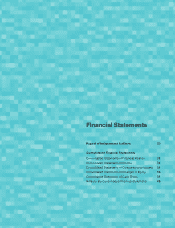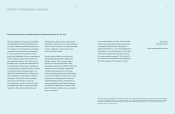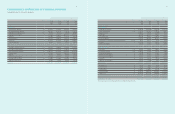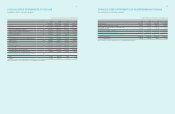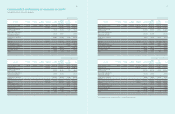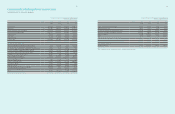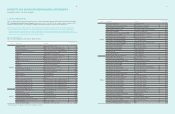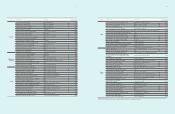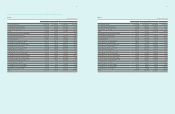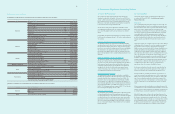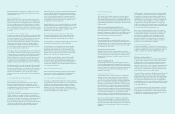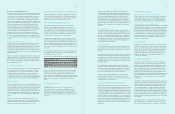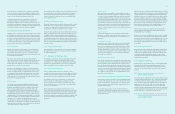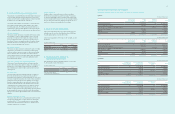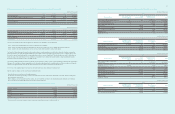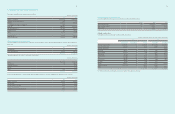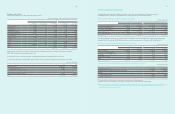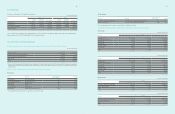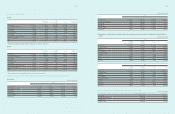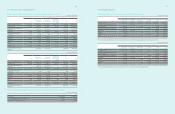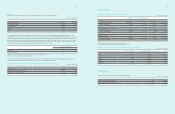Samsung 2011 Annual Report Download - page 27
Download and view the complete annual report
Please find page 27 of the 2011 Samsung annual report below. You can navigate through the pages in the report by either clicking on the pages listed below, or by using the keyword search tool below to find specific information within the annual report.
48
49
had directly disposed of the related assets or liabilities. This may mean
that amounts previously recognized in other comprehensive income are
reclassified to profit or loss.
B) Non-controlling interests
Profit or loss and each component of other comprehensive income are
attributed to the owners of the parent and to the non-controlling interests.
Total comprehensive income is attributed to the owners of the parent and
to the non-controlling interests even if this results in the non-controlling
interests having a deficit balance. And changes in a parent’s ownership
interest in a subsidiary that do not result in a loss of control are accounted
for as equity transactions (i.e. transactions among owners in their capacity
as owners).
C) Associated companies and joint ventures
Investments in companies in which the Company does not have the ability
to directly or indirectly control the financial and operating decisions, but
does possess the ability to exercise significant influence, are accounted
for using the equity method. Generally, it is presumed that if at least
20% of the voting stock and potential voting rights is owned, significant
influence exists. The Company’s investment in associates includes
goodwill identified on acquisition, net of any accumulated impairment
loss. Investments in companies in which the Company has joint control
are also accounted for using the equity method.
The company’s share of post-acquisition profit or loss is recognized in the
income statement, and its share of post acquisition movements in other
comprehensive income is recognized in other comprehensive income with
a corresponding adjustment to the carrying amount of the investment.
When the Company’s share of losses in an associate equals or exceeds
its interest in the associate, including any other unsecured receivables,
the Company does not recognize further losses, unless it has incurred
obligations or made payments on behalf of the associate or joint venture.
Unrealized gains and loss on transactions between the Company and its
associates are eliminated to the extent of the parent company’s interest
in the associates and joint ventures. Unrealized losses are also eliminated
unless the transaction provides evidence of an impairment of the asset
transferred. Accounting policies of associates have been changed
where necessary to ensure consistency with the policies adopted by the
Company.
2.3 Foreign Currency Translation
A) Functional and presentation currency
Items included in the financial statements of each of the Company’s
entities are measured using the currency of the primary economic
environment in which an entity operates (‘the functional currency’). The
consolidated financial statements are presented in Korean Won, which is
the SEC’s functional and presentation currency.
B) Transactions and balances
Foreign currency transactions are translated into the functional currency
using the exchange rates prevailing at the dates of the transactions or
valuation where items are remeasured. Foreign exchange gains and losses
resulting from the settlement of such transactions and from the translation
at the exchange rate at the end of the reporting period of monetary
assets denominated in foreign currencies are recognized in the statement
of income, except when deferred in other comprehensive income as
qualifying cash flow hedges and qualifying net investment hedges.
Changes in the fair value of monetary securities denominated in foreign
currency classified as available-for-sale financial assets are analyzed
between translation differences resulting from changes in the amortized
cost of the security and other changes in the carrying amount of the
security. Translation differences related to changes in amortized cost are
recognized in profit or loss, and other changes in carrying amount are
recognized in other comprehensive income.
Translation differences on non-monetary financial assets such as equities
held at fair value through profit or loss are recognized in profit or loss as
part of the fair value gain or loss. Translation differences on non-monetary
financial assets such as equities classified as available-for-sale are
included in other comprehensive income.
C) Translation of financial statements of foreign subsidiaries
The results and financial position of all the foreign entities that have
a functional currency different from the presentation currency of the
Company are translated into the presentation currency as follows :
Assets and liabilities for each statement of financial position presented are
translated at the closing rate at the end of the reporting date.
Income and expenses for each statement of income are translated
at average exchange rates, unless this average is not a reasonable
approximation of the cumulative effect of the rates prevailing on the
transaction dates, in which case income and expenses are translated
at the rate on the dates of the transactions; and all resulting exchange
differences are recognized in other comprehensive income.
On consolidation, exchange differences arising from the translation
of the net investment in foreign operations are recognized in other
comprehensive income. When a foreign operation is partially disposed
of or sold, the exchange differences that were recorded in equity are
reclassified in the statement of income during the period when the gain or
loss is recognized in profit or loss.
2.4 Cash Flow Statements
Cash flow statements are prepared using the indirect method. Foreign
currency cash flows have been translated into Korean Won using the
average rates of exchange for the period under consideration.
2.5 Cash and Cash Equivalents
The Company considers all highly liquid investments with less than three
months maturity from the date of acquisition to be cash equivalents. Bank
overdrafts are considered as short-term borrowings in the statement
of financial position and treated as financing activities in the cash flow
statements, unless the overdraft is repayable on demand and used for
cash management purposes only, in which case the overdraft is treated as
cash and cash equivalents in the cash flow statement.
2.6 Financial Assets
A) Classification
The Company classifies its financial assets in the following categories :
at fair value through profit or loss, loans and receivables, available-for-
sale, and held-to-maturity investments. The classification depends on the
terms of the instruments and purpose for which the financial assets were
acquired. Management determines the classification of its financial assets
at initial recognition.
(1) Financial assets at fair value through profit or loss
Financial assets at fair value through profit or loss are financial assets
held for trading. A financial asset is classified in this category if acquired
principally for the purpose of selling in the short-term. Derivatives are also
categorised as held for trading unless they are designated as hedges.
Assets in this category are classified as current assets.
(2) Loans and receivables
Loans and receivables are non-derivative financial assets with fixed or
determinable payments that are not quoted in an active market. They are
included in current assets, except for those with maturities greater than 12
months after the end of the reporting period; such loans and receivables
are classified as non-current assets.
(3) Available-for-sale financial assets
Available-for-sale financial assets are non derivatives that are either
designated in this category or not classified in any of the other categories.
They are included in non-current assets unless an investment matures or
management intends to dispose of it within 12 months of the end of the
reporting period.
(4) Held-to-maturity investments
Held-to-maturity investments are non-derivative financial assets with
fixed or determinable payments and fixed maturity that an entity has the
positive intention and ability to hold to maturity. Held-to-maturity financial
assets are included in non-current assets, except for those with maturities
less than 12 months from the end of the reporting period, which are
classified as current assets.
B) Recognition and measurement
Regular purchases and sales of financial assets are recognized on the
trade date – the date on which the Company commits to purchase
or sell the asset. Investments are initially recognized at fair value plus
transaction costs for all financial assets not carried at fair value through
profit or loss. Financial assets carried at fair value through profit or loss
are initially recognized at fair value, and transaction costs are expensed
in the statement of income. Financial assets are derecognized when the
rights to receive cash flows from the investments have expired or have
been transferred and the Company has transferred substantially all risks
and rewards of ownership. Available-for-sale financial assets and financial
assets at fair value through profit or loss are subsequently carried at
fair value. Loans and receivables and held-to-maturity investments are
subsequently carried at amortized cost using the effective interest method.
Gains or losses arising from changes in the fair value of the financial
assets at fair value through profit or loss category are presented in the
statement of income in the period in which they arise. Dividend income
from financial assets at fair value through profit or loss is recognized in the
statement of income when the Company’s right to receive payments is
established.
Equity instruments of which the fair value cannot be measured reliably
are recognized as cost. Changes in the fair value of monetary securities
denominated in a foreign currency and classified as available-for-sale
are analyzed between translation differences resulting from changes in
amortized cost of the security and other changes in the carrying amount
of the security. The translation differences on monetary securities are
recognized in profit or loss; translation differences on non-monetary
securities are recognized in other comprehensive income. Changes in the
fair value of monetary and non-monetary securities classified as available-
for-sale are recognized in other comprehensive income.
When securities classified as available-for-sale are sold or impaired,
the accumulated fair value adjustments previously recognized in equity
are transferred to the statement of income. Interest on available-for-
sale financial assets calculated using the effective interest method
is recognized in the statement of income as part of finance income.
Dividends on available-for sale equity instruments are recognized in
the statement of income as part of other operating income when the
Company’s right to receive payments is established.
C) Offsetting financial instruments
Financial assets and liabilities are offset and the net amount reported in
the statement of financial position when there is a legally enforceable right
to offset the recognized amounts and there is an intention to settle on a
net basis, or realize the asset and settle the liability simultaneously.
D) Impairment of financial assets
(1) Assets carried at amortized cost
The Company assesses at the end of each reporting period whether there
is objective evidence that a financial asset or group of financial assets
is impaired. A financial asset or a group of financial assets is impaired
and impairment loss is incurred only if there is objective evidence of
impairment as a result of one or more events that occurred after the initial
recognition of the asset (a ‘loss event’) and that loss event (or events)
has an impact on the estimated future cash flows of the financial asset or
group of financial assets that can be reliably estimated.
The amount of the loss is measured as the difference between the asset’s
carrying amount and the present value of estimated future cash flows
(excluding future credit losses that have not been incurred) discounted at
the financial asset’s original effective interest rate. The carrying amount
of the asset is reduced and the amount of the loss is recognized in the
consolidated statement of income. As a practical expedient, the Company
may measure impairment on the basis of an instrument’s fair value using
an observable market price.
If, in a subsequent period, the amount of the impairment loss decreases
and the decrease can be related objectively to an event occurring after
the impairment was recognized (such as an improvement in the debtor’s
credit rating), the reversal of the previously recognized impairment loss is
recognized in the consolidated statement of income.


